Hyperlinks in Revu can be either text or graphic elements that, when clicked, take the user to another part of the same document, to a different document or to a website. The Links tab in Revu makes it easy to add, change and manage hyperlinks.
Go to View > ![]() Tabs >
Tabs > ![]() Links or press ALT+N to show the
Links or press ALT+N to show the ![]() Links tab.
Links tab.
Any hyperlinks in a PDF are listed in the Hyperlinks section of the Links tab.
There are several actions available in the toolbar just above the list of hyperlinks:
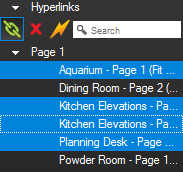
![]() Hyperlink: Creates hyperlinks in a PDF.
Hyperlink: Creates hyperlinks in a PDF.
![]() Delete: Deletes the currently selected hyperlink(s).
Delete: Deletes the currently selected hyperlink(s).
![]()
![]() Edit Action: Brings up the Action dialog box to define what happens when the link is clicked.
Edit Action: Brings up the Action dialog box to define what happens when the link is clicked.
![]() Search: Filters the hyperlinks list by the text entered into the field. Useful for documents with a large number of links.
Search: Filters the hyperlinks list by the text entered into the field. Useful for documents with a large number of links.
Click a hyperlink from the list to jump to it on the PDF. Hold SHIFT or CTRL while clicking to select multiple hyperlinks.
Hyperlinks can be created for an area on a PDF or for selected (non-scanned) text. Of course, you can also define the area over text as a hyperlink to simulate the hyperlinking of scanned text.
The procedures below start by selecting the Hyperlink command from the Command bar, but you can just as easily click the Hyperlink button from the Links tab if you have it open.
To add a hyperlink to a defined area:
To add a hyperlink to text:
You can also create hyperlinks directly to selected files from the ![]() File Access tab. To do that, open the
File Access tab. To do that, open the ![]() File Access tab and then:
File Access tab and then:
Hyperlinks can also be created to Places in a PDF, which are defined and named anchors than can be placed anywhere on a document so that you can easily link to that location. Places can be moved on the PDF without breaking links to them, provided that their names remain unchanged.
To create a Place:
In the Places section of the Links tab, click ![]() Add Place.
Add Place.
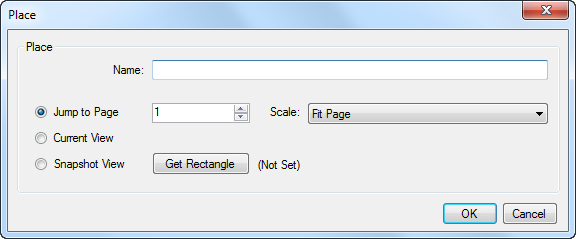
Select one of the following options to describe the location of the Place:
To create a link to a Place, open the Links tab and:
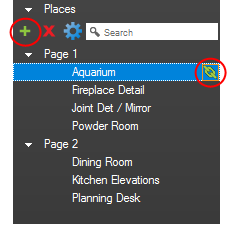
The Action dialog box allows you to define the action a hyperlink will take when clicked. When creating a new hyperlink, the Action dialog box will open automatically once the hyperlink area or text is selected. To edit an existing hyperlink, select it on the Links tab and click the ![]() Edit Action button on the toolbar. Whether creating a new hyperlink or editing an existing one, the process is the same:
Edit Action button on the toolbar. Whether creating a new hyperlink or editing an existing one, the process is the same:
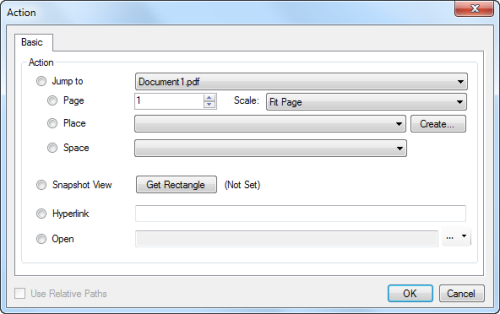
There are
Jump to Page: Moves to a specific page number in a selected PDF. To set this action:
Jump to Place: Moves to a predefined Place on a PDF. The location of a Place can be changed later without breaking the action. To set this action:
Jump to Space: Moves to a predefined Space on a PDF. To set this action:
Note: If an Action is set to jump to a Space that is subsequently deleted, the Action will be automatically converted to Snapshot View, as described below.
Snapshot View: Moves to a specific, zoomed in area of the current PDF. This option is useful for zooming into specific views of a region of a large format drawing, such as a particular elevation detail. Click Get Rectangle to define the area of the drawing to jump to.
Hyperlink: Opens the URL entered in the Hyperlink field. The URL will open in
Open: Opens the file specified in the Open File field. Click  button
button
Use Relative Paths: Revu can store either a full or relative path to a file. When a full path is stored, the location of the file is defined from the drive it resides on; when a relative path is stored, it defines the location of the linked file relative to the current file. A full path is best when you plan to move the file storing the link but not the file being linked to, such as when the linked file resides on a network drive that is accessible to all users. A relative path is best when both files are liable to be moved, such as when you are archiving an entire project to CD, or moving a project to another computer. For more information and Relative vs Full Path, see Understanding Relative vs Full Paths.
To use a relative path to the file being linked to, select Use Relative Paths. This will cause the link to recognize the location of the file in relation to its home folder (for example, to know that the file's home folder is two levels up or down in the folder hierarchy). This is recommended when project files are liable to be moved together as a group from one drive to another.
To use a full path to the file being linked to, do not select Use Relative Paths. This will cause the link to recognize the exact location of the file being linked to. This is recommended when the file that contains the hyperlink is liable to be moved to another drive, but the file being linked to will stay put.
See the Help Guide in Revu for a more detailed discussion of Relative vs Full Paths.
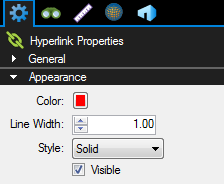 If you want a hyperlink to stay visible all the time, check the Visible option on its
If you want a hyperlink to stay visible all the time, check the Visible option on its